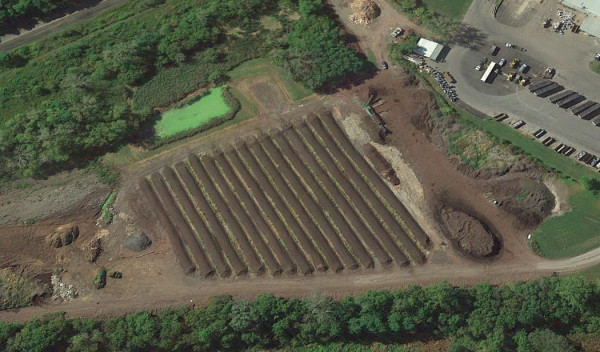Compost Site

The Authority began operating its Green Waste Compost Facility in 1992. This regional facility serves approximately 17 area municipalities and a number of private haulers, businesses, institutions and landscapers. About two-thirds of the population of Oneida-Herkimer Counties utilizes the site.
Each year, the Authority receives thousands of tons of brush, leaves and grass clippings at the site. Brush is ground into wood chips for use as mulch. Leaves and grass are processed through a windrow composting system into high-quality compost. A windrow is an elongated pile of material, which is periodically turned and aerated. Using this method it takes about 3-4 months to make finished compost. The site employs a large tub grinder, single pass windrow turner, two loaders, and high capacity trommel screen. Compost is monitored for moisture, temperature, and maturity. It is screened before entering the market.
The Authority's yard waste compost has been certified by the US Composting Council under its Seal of Testing Assurance Program as consistent, high-quality compost. This means the Authority's compost has been tested by third party laboratories to ensure that it meets all state and federal environmental requirements.
The composting program is an exciting opportunity for area residents because it represents a "full circle" process within our two-county solid waste management system. The compost is made from area residents' yard waste and now can be returned in a useful form to their gardens and lawns.
Green Waste, Root Balls, Stumps & Compost Flyer
COMPOST APPLICATION RATES
The Oneida-Herkimer Solid Waste Authority's yard waste compost has been certified by the US Composting Council under its Seal of Testing Assurance Program as consistent, high-quality compost. This means the Authority's compost has been tested by third party laboratories to ensure that it meets all state and federal environmental requirements.

Compost Test Results
The Oneida-Herkimer Solid Waste Authority produces high quality compost from municipal yard waste generated in our two county area. Our finished compost is made entirely from processed brush, leaves and grass clippings, fully cured and screened to 1/2”. No sewage sludge or solid wastes are included in our compost mix. Compost alone is not a fertilizer. Compost should be used as a soil additive to develop or improve moisture retention and add important organic matter. Compost worked into clay or sandy soils improves texture, helps with compaction and aerates the soil, thereby facilitating grass and turf root development. It can also be used as a substitute for landscaping mulch or peat moss.
Lawn Establishment and Maintenance
Establishment: Apply 1 - 2 inches of compost to the new lawn area. Incorporate into the soil to a depth of 5 – 8 inches. Rake soil surface smooth prior to applying seed. Apply seed as required. Lightly water the newly seeded area.
Maintenance: Apply fine layer of ¼ to ½ inch of compost and rake evenly across the lawn. Reseed if needed and lightly water.
Flower Bed and Garden Soil Maintenance
Apply about 2 inches of compost to the garden. Blend with existing soil to a depth of 6 - 8 inches
Landscaping Development and Maintenance
Apply 1 – 3 inches of compost around planting beds, trees and shrubs.
Tree and Shrub Planting
Excavate a hole slightly shallower and 2 to 3 times the width of the root ball or container. Uniformly blend compost with the excavated soil at 1 part compost to 2-3 parts soil. Back-fill and firm the soil/compost blend around loose roots and root ball within the planting hole. Water trees and shrubs thoroughly after planting.
Address
824 Sewage Plant Road Utica, NY 13502Hours of Operation
- Mon-Fri: 7am-3pm
- Sat: 7am-2pm (NO BULK COMPOST LOADS)
- Sun: CLOSED